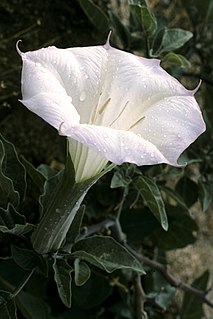
Datura is a genus of nine species of poisonous, vespertine-flowering plants belonging to the nightshade family Solanaceae. They are commonly known as thornapples or jimsonweeds, but are also known as devil's trumpets. Other English common names include moonflower, devil's weed, and hell's bells. All species of Datura are poisonous and potentially psychoactive, especially their seeds and flowers, which can cause respiratory depression, arrhythmias, fever, delirium, hallucinations, anticholinergic syndrome, psychosis, and even death if taken internally. Due to their effects and symptoms, they have occasionally been used not only as poisons, but also as hallucinogens by various groups throughout history. Traditionally, psychoactive administration of Datura species has often been associated with witchcraft and sorcery or similar practices in many cultures, including the Western world. Certain common Datura species have also been used ritualistically as entheogens by some Native American groups. Nonpsychoactive use of the plant is usually done for medicinal purposes, and the alkaloids present in plants of the Datura genus have long been considered traditional medicines in both the New and Old Worlds due to the presence of the alkaloids scopolamine and atropine, which are also produced by Old World plants such as Hyoscyamus niger, Atropa belladonna, and Mandragora officinarum.

Leucorchestris arenicola, commonly called the dancing white lady spider, is a huntsman spider in the family Sparassidae and genus Leucorchestris. It is commonly found in the Namib desert of Namibia. It is often mistaken with the similarly named Carparachne aureoflava, or more commonly known as the wheel spider from the same location. L. arenicola relies on seismic vibrations, called drumming, for communication. It taps its foremost legs on the sand to send messages to other white lady spiders. Male L. arenicola will travel over 50 m in one night searching for a mate. If they find a mate, they must be extremely careful, for drumming the wrong message can be deadly. One of the major features that characterizes its nocturnal behavior is its specialized vision, using eight eyes in different orientations to capture a panoramic view of the surroundings. L. arenicola spiders use temporal summation in order to be able to see dim lighting during night-time wanderings. The species was first described by Reginald Frederick Lawrence in 1962, who described all the species in the genus Leucorchestris.
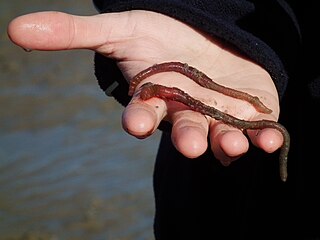
The lugworm or sandworm is a large marine worm of the phylum Annelida. Its coiled castings are a familiar sight on a beach at low tide but the animal itself is rarely seen except by those who, from curiosity or to use as fishing bait, dig the worm out of the sand.
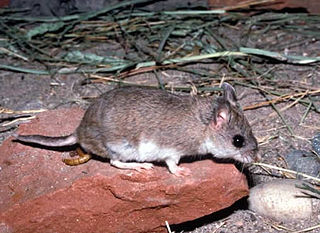
Mearns's grasshopper mouse or the Chihuahuan grasshopper mouse is a grasshopper mouse found in southwestern New Mexico, West Texas, and north-central Mexico. They are similar to Onychomys torridus, but differ in karyotype and size. This mouse is smaller in every regard except for the nasal length of the skull.

Pexicopia is a genus of moths in the family Gelechiidae. It contains 22 species, such as the hollyhock seed moth, which is found in Europe.
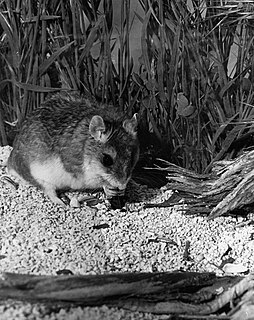
Grasshopper mice are rodents of the genus Onychomys, occurring in North America. They feed on insects and arthropods.

Caladenia arenicola, commonly known as the carousel spider orchid, is a plant in the orchid family Orchidaceae and is endemic to the south-west of Western Australia. It has a single erect, hairy leaf and up to three red, white and green flowers on a flowering stem up to 60 cm (20 in) high. It is a common species on the Swan Coastal Plain, where it grows in sandy soil under trees.
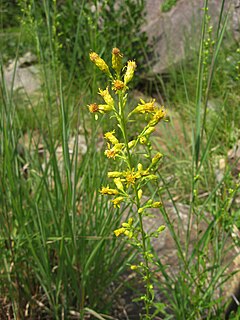
Solidago arenicola is a rare species of flowering plant in the family Asteraceae known by the common name Locust Fork goldenrod. It has been found only in the states of Tennessee and Alabama in the United States. It is endemic to riverside scour areas on the Cumberland Plateau, where it is often locally abundant.
Apatetrinae is a subfamily of moths in the family Gelechiidae. The subfamily was described by Edward Meyrick in 1947.
Pexicopia catharia is a moth of the family Gelechiidae. It was described by Ian Francis Bell Common in 1958. It is found in Australia, where it has been recorded from New South Wales and Queensland.
Pexicopia cryphia is a moth of the family Gelechiidae. It was described by Ian Francis Bell Common in 1958. It is found in Australia, where it has been recorded from Queensland.
Pexicopia dascia is a moth of the family Gelechiidae. It was described by Ian Francis Bell Common in 1958. It is found in Australia, where it has been recorded from Queensland.
Pexicopia diasema is a moth of the family Gelechiidae. It was described by Ian Francis Bell Common in 1958. It is found in Australia, where it has been recorded from Queensland.
Pexicopia mimetica is a moth of the family Gelechiidae. It was described by Ian Francis Bell Common in 1958. It is found in Australia, where it has been recorded from Queensland.
Pexicopia paliscia is a moth of the family Gelechiidae. It was described by Ian Francis Bell Common in 1958. It is found in Australia, where it has been recorded from Queensland and New South Wales.
Pexicopia pheletes is a moth of the family Gelechiidae. It was described by Ian Francis Bell Common in 1958. It is found in Australia, where it has been recorded from Queensland.
Pexicopia proselia is a moth of the family Gelechiidae. It was described by Ian Francis Bell Common in 1958. It is found in Australia, where it has been recorded from Queensland.
Pexicopia karachiella is a moth of the family Gelechiidae. It was described by Hans Georg Amsel in 1968 and is found in western Pakistan.
Pterostylis arenicola, commonly known as the sandhill rustyhood is a plant in the orchid family Orchidaceae and is endemic to South Australia. It has a rosette of leaves near its base and up to ten reddish-brown and white flowers with a dark brown, insect-like labellum. Its distribution is now restricted to areas around Lake Alexandrina.







